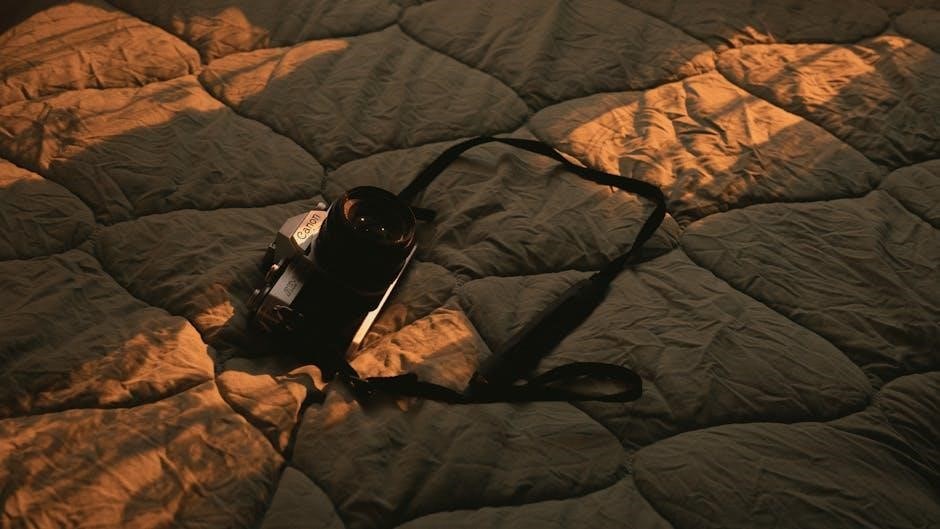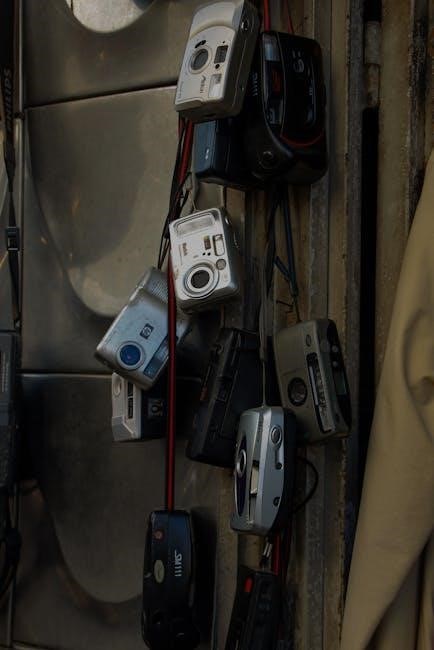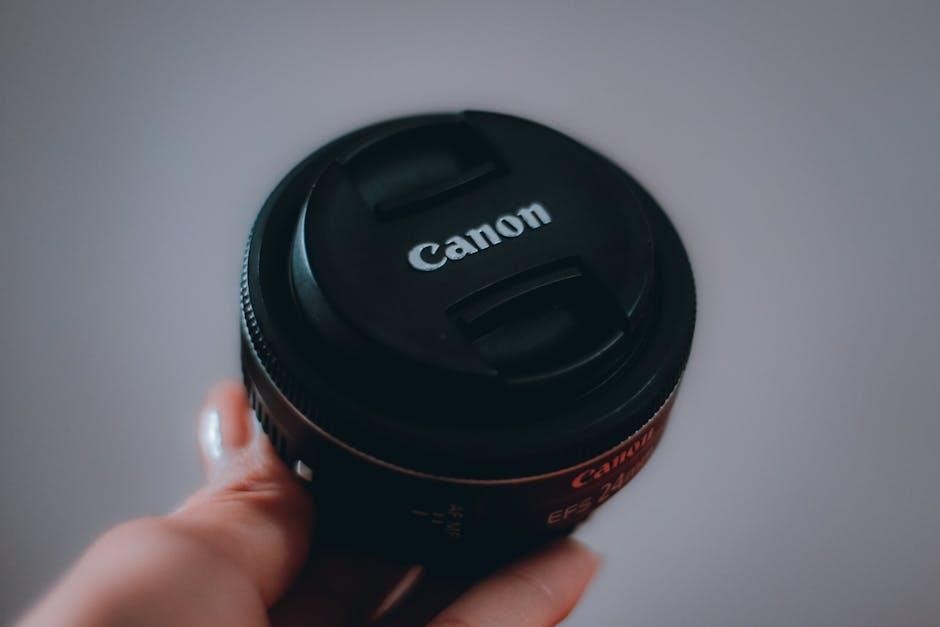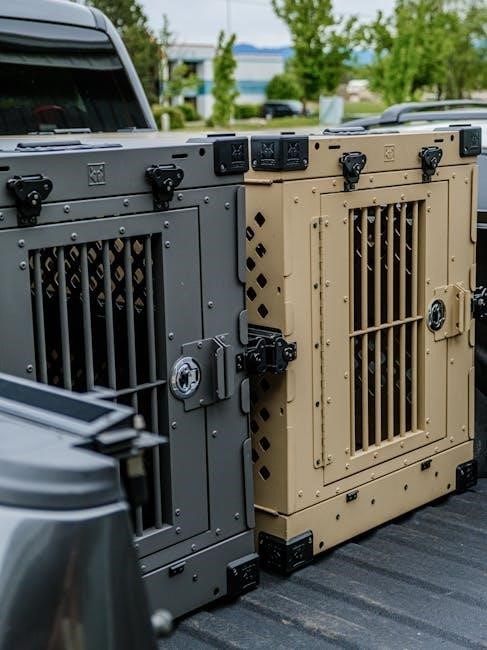
canon eos70d manual
The Canon EOS 70D manual provides comprehensive guidance for mastering this advanced DSLR camera, covering features, settings, and techniques to enhance photography and videography skills effectively.
Overview of the Canon EOS 70D
The Canon EOS 70D is a high-performance DSLR camera designed for enthusiasts and professionals. It features a 20.2MP APS-C CMOS sensor, Dual Pixel AF for precise autofocus, and built-in Wi-Fi for seamless connectivity. The vari-angle touchscreen LCD enhances shooting versatility, making it ideal for both still photography and video recording.
Importance of Reading the Manual
Reading the Canon EOS 70D manual is essential for unlocking its full potential. It provides detailed insights into advanced features, helping users optimize their photography skills. The manual also serves as a troubleshooting guide, ensuring you can resolve issues quickly and make the most of your camera’s capabilities.
Key Features of the Canon EOS 70D
The Canon EOS 70D boasts a 20.2MP APS-C CMOS sensor, Dual Pixel AF, and built-in Wi-Fi, offering advanced imaging capabilities, fast autofocus, and seamless connectivity options for enhanced creativity and convenience.
20.2 Megapixel APS-C CMOS Sensor
The Canon EOS 70D features a high-resolution 20.2-megapixel APS-C CMOS sensor, delivering crisp images with excellent detail and color accuracy. This sensor ensures superior performance in various lighting conditions, capturing vibrant colors and subtle tones. Its advanced design minimizes noise, providing clean images even at higher ISO settings, making it ideal for both still photography and video recording.
Dual Pixel AF for Enhanced Autofocus
Dual Pixel AF revolutionizes autofocus with its advanced phase-detection technology, embedded directly on the image sensor. This system enables fast, precise, and smooth focusing during still photography and video recording. It captures sharp images with minimal blur, ensuring subjects stay in focus, even with complex compositions or dynamic movements, making it ideal for wildlife, sports, and cinematic applications.
Built-in Wi-Fi for Wireless Connectivity
The Canon EOS 70D features built-in Wi-Fi, allowing seamless wireless connectivity to transfer images and videos to smart devices or computers. This functionality supports remote shooting and sharing, enhancing convenience for photographers. The Wi-Fi capability also enables easy pairing with Canon’s EOS Utility software, offering advanced control and workflow options for professional and amateur shooters alike.

Navigating the Camera Menu
The Canon EOS 70D’s menu system is user-friendly, with tabs for shooting, playback, and setup. Customize options like the Quick Control Screen for easy access to frequently used settings.
Understanding the Menu Structure
The Canon EOS 70D menu is divided into color-coded tabs: red for shooting settings, blue for playback options, and orange for setup; Each tab contains submenus with specific controls, allowing users to quickly locate and adjust camera functions. The menu’s logical organization ensures intuitive navigation, making it easier to customize settings for optimal performance and personal preferences, even for advanced photographers seeking detailed adjustments to enhance their creative workflow and achieve precise results in various shooting conditions;
Customizing the Quick Control Screen
The Canon EOS 70D allows users to customize the Quick Control Screen, enabling quick access to frequently used settings. By accessing the menu, users can select up to 6 functions from a list of 11 options, including AF, metering modes, and ISO. This personalization streamlines workflow, ensuring essential controls are readily available, enhancing efficiency during shoots and minimizing menu navigation time for a more intuitive and tailored shooting experience.

Shooting Modes Explained
The Canon EOS 70D offers various shooting modes, including Creative Zone and Basic Zone options, designed to cater to different photography styles and skill levels effectively.
Creative Zone Modes (P, Tv, Av, M)
Creative Zone modes on the Canon EOS 70D offer advanced control for photographers. Program (P) mode balances aperture and shutter speed automatically, while Tv (Shutter Priority), Av (Aperture Priority), and M (Manual) modes allow full control over exposure settings, enabling precise adjustments for creative results in various lighting conditions and photography styles.
Basic Zone Modes (Scene, Creative Filters)
Basic Zone modes simplify photography with predefined settings for common scenarios. Scene modes like Portrait, Landscape, and Close-up optimize camera settings for specific subjects. Creative Filters, such as Grainy B&W or Miniature, add artistic effects to images. These modes are ideal for beginners or those seeking effortless, visually appealing results without manual adjustments.
Autofocus Settings and Techniques
Mastering autofocus on the Canon EOS 70D enhances image sharpness. Techniques include selecting AF points, using AI Servo for moving subjects, and customizing AF settings for precision.
Single Shot AF vs. Continuous AF
Single Shot AF locks focus on a stationary subject with a half-press of the shutter, ideal for still photography. Continuous AF tracks moving subjects, adjusting focus dynamically. Use Single Shot for precise focus on static objects and Continuous AF for capturing sharp images of action or wildlife. Both modes can be customized for optimal performance.
Configuring AF Points and Zones
Canon EOS 70D offers flexible AF point configuration. Users can manually select AF points or use zones for dynamic subject tracking. The camera supports up to 19 cross-type AF points for precise focus. Customizing AF zones enhances responsiveness and accuracy, allowing photographers to prioritize specific areas of the frame for optimal results in various shooting scenarios.
Metering Modes and Exposure Control
Metering modes in the Canon EOS 70D include Evaluative, Center-Weighted, and Spot options, ensuring precise light measurement. Exposure control allows for manual adjustments to achieve desired results.
Understanding Different Metering Modes
The Canon EOS 70D offers three metering modes: Evaluative, Center-Weighted, and Spot. Evaluative metering analyzes the entire scene for balanced exposure. Center-Weighted focuses on the central area, prioritizing subjects. Spot metering measures light from a specific point, ideal for challenging lighting conditions. Each mode provides flexibility to capture accurate exposures in various shooting scenarios.
Adjusting Exposure Compensation
Exposure compensation on the Canon EOS 70D allows you to adjust brightness ±5 stops in 1/3-stop increments. Accessed via the Quick Control dial or menu, it fine-tunes exposure for backlit or high-contrast scenes, ensuring optimal image brightness without bracketing, enhancing flexibility for precise control over lighting conditions in various photography situations.
ISO and Noise Reduction
The Canon EOS 70D offers an ISO range of 100-12800, minimizing noise in low-light conditions. Use noise reduction features wisely to maintain image quality while reducing digital artifacts.
ISO Sensitivity Range and Best Practices
The Canon EOS 70D features an ISO range of 100-12800, allowing flexibility in various lighting conditions. For optimal results, use lower ISOs (100-400) in bright light to minimize noise and digital artifacts. In low-light situations, higher ISOs can be effective, but balance with noise reduction settings to preserve image quality and details effectively always.
Noise Reduction Settings and Techniques
The Canon EOS 70D offers Long Exposure and High ISO noise reduction settings to minimize grain in images. Enable these in the menu for cleaner results in low-light conditions. Use a tripod for long exposures to avoid camera shake. Shoot in RAW for better post-processing control. Balance noise reduction with detail preservation for optimal image quality and natural appearance in your photos always.

White Balance and Color Temperature
White balance ensures accurate color representation by adjusting to lighting conditions. The Canon EOS 70D offers presets like Auto, Daylight, and Shade, plus custom options for precise control.
Understanding White Balance Modes
The Canon EOS 70D offers multiple white balance modes, including Auto, Daylight, Shade, Tungsten, Fluorescent, and Flash. Each mode adjusts color temperature to match lighting conditions, ensuring accurate color rendition. Auto mode automatically detects and adjusts white balance, while custom settings allow precise calibration for specific environments, enhancing overall image quality and visual authenticity effectively.
Setting Custom White Balance
Custom white balance on the Canon EOS 70D allows precise color calibration. Use a white object or gray card under current lighting to set a custom balance. The camera captures the light’s color temperature, ensuring neutral tones in your images. This feature is ideal for challenging lighting conditions, providing professional-level control over color accuracy and enhancing your photography’s overall quality effectively.

Burst Mode and Continuous Shooting
Master burst mode and continuous shooting with the Canon EOS 70D to capture dynamic action sequences effortlessly, ensuring every moment is sharp and perfectly framed.
Configuring Burst Mode Settings
Customize burst mode settings on your Canon EOS 70D by accessing the camera menu. Adjust the frame rate and buffer capacity to optimize performance for high-speed photography. Enable continuous shooting modes through the Drive Mode settings, ensuring rapid capture of sequential shots. This feature is ideal for sports and wildlife photography, allowing photographers to freeze fleeting moments with precision and clarity, making it an essential tool for dynamic action photography.
Optimizing Memory Cards for Burst Shooting
For efficient burst shooting on the Canon EOS 70D, use high-speed memory cards with a minimum U3 rating. Format cards regularly to maintain performance and ensure compatibility. Shoot in RAW or JPEG to optimize buffer capacity. Store high-speed cards securely and avoid overfilling them to maintain reliability, ensuring smooth and uninterrupted burst shooting sessions with your camera.
Video Recording and Movie Mode
The Canon EOS 70D excels in video recording, offering HD and Full HD shooting with manual focus control and Dual Pixel AF for smooth subject tracking during filming.
HD and Full HD Video Shooting
The Canon EOS 70D supports HD (1280×720) and Full HD (1920×1080) video recording at various frame rates, ensuring high-quality footage. Manual focus control and Dual Pixel AF enhance clarity and tracking, while built-in Wi-Fi enables easy sharing. The camera’s vari-angle touchscreen simplifies framing, making it ideal for both casual and professional videography needs.
Manual Controls in Movie Mode
In Movie Mode, the Canon EOS 70D offers manual controls for aperture, shutter speed, and ISO, allowing precise adjustments. Exposure compensation and audio level adjustments ensure tailored settings. The touchscreen enables focus adjustments during recording, while built-in Wi-Fi supports remote operation, enhancing creative control for professional-grade video production.
Troubleshooting Common Issues
Addressing common issues like error messages and camera malfunctions is simplified with the Canon EOS 70D manual, providing clear solutions and reset options for optimal functionality.
Resolving Error Messages
Encountering error messages on your Canon EOS 70D? The manual guides you through troubleshooting steps, such as checking memory card compatibility or lens connections. For issues like “Err 01,” it recommends resetting the camera or updating firmware. If problems persist, restoring factory settings or consulting Canon support is advised to ensure optimal functionality and prevent data loss during shoots.
Resetting the Camera to Factory Settings
Resetting the Canon EOS 70D to factory settings restores default configurations, resolving persistent issues without affecting stored images. Access the menu, navigate to the wrench icon, and select “Reset Camera Settings.” Choose “OK” to confirm. This process erases custom settings, returning the camera to its original state for a fresh start. Use this option when troubleshooting fails to resolve operational problems effectively and efficiently.
Related Posts

taylor indoor/outdoor thermometer manual 1502
Download the Taylor indoor/outdoor thermometer 1502 manual for easy setup and accurate temperature readings. Get the most out of your device with our comprehensive guide.

2014 ford f 150 owners manual
Get the free 2014 Ford F-150 owner’s manual. Comprehensive guide with maintenance tips, features, and repair info. Download now!

xnx universal transmitter user manual
Get the XNX Universal Transmitter User Manual for setup, operation, and troubleshooting. Download the comprehensive guide now!